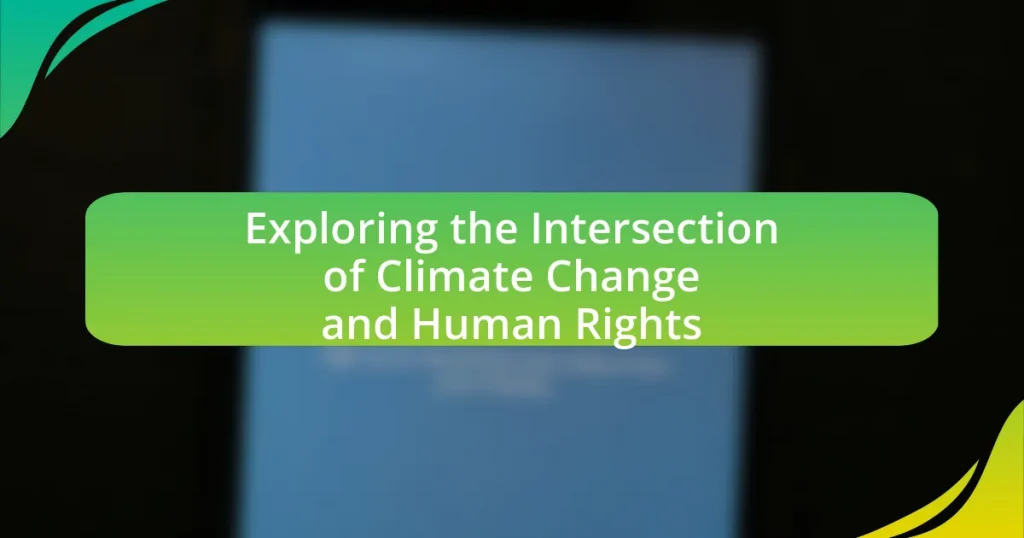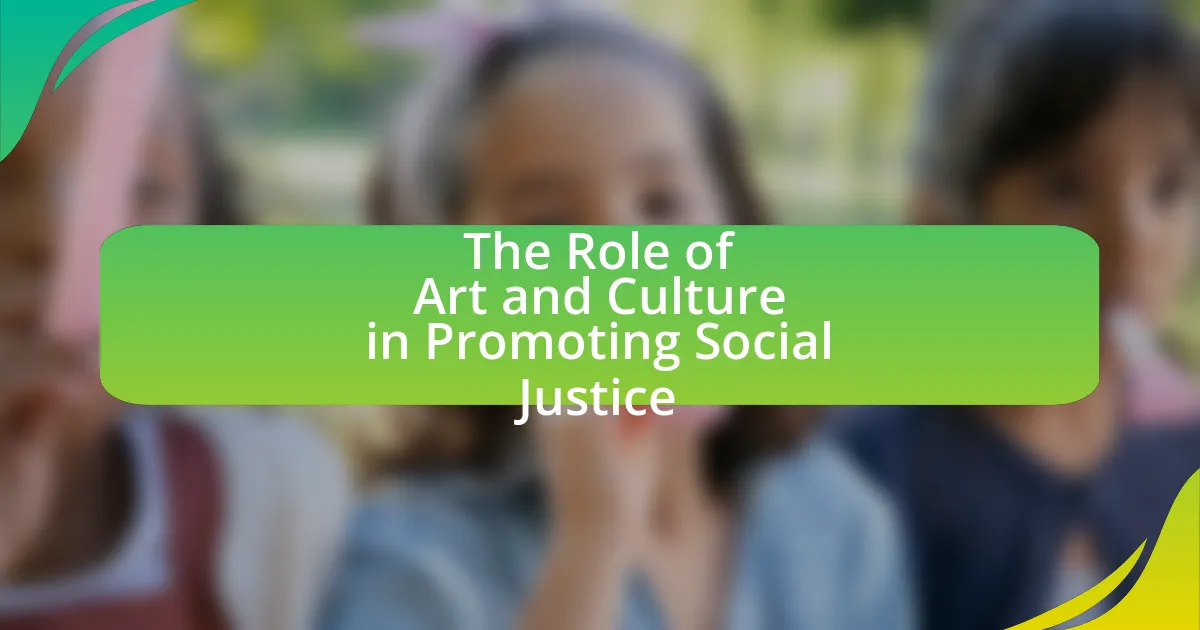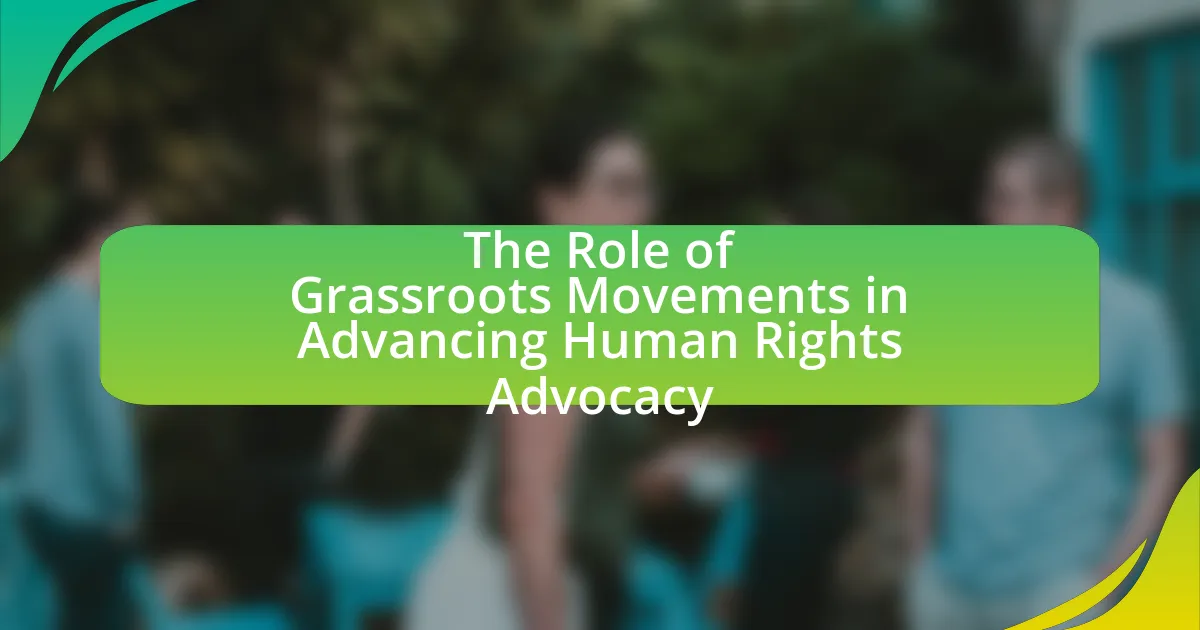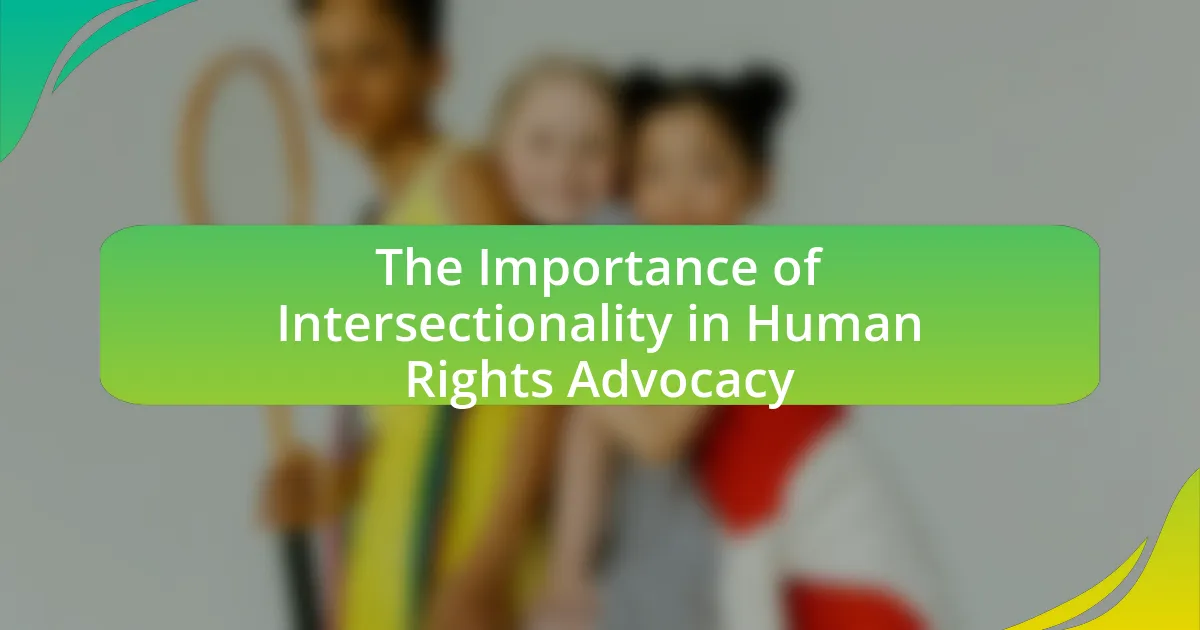The article explores the critical intersection of climate change and human rights, emphasizing how environmental degradation threatens fundamental rights such as life, health, food, and water access. It highlights the disproportionate impact of climate change on vulnerable populations, including indigenous peoples and low-income communities, leading to increased poverty, displacement, and health risks. Key human rights affected by climate change are identified, alongside the necessity of integrating human rights frameworks into climate policies to ensure equitable outcomes. The article also discusses the role of governments, international agreements, and grassroots movements in addressing these interconnected issues, while providing practical steps for individuals to advocate for climate justice.
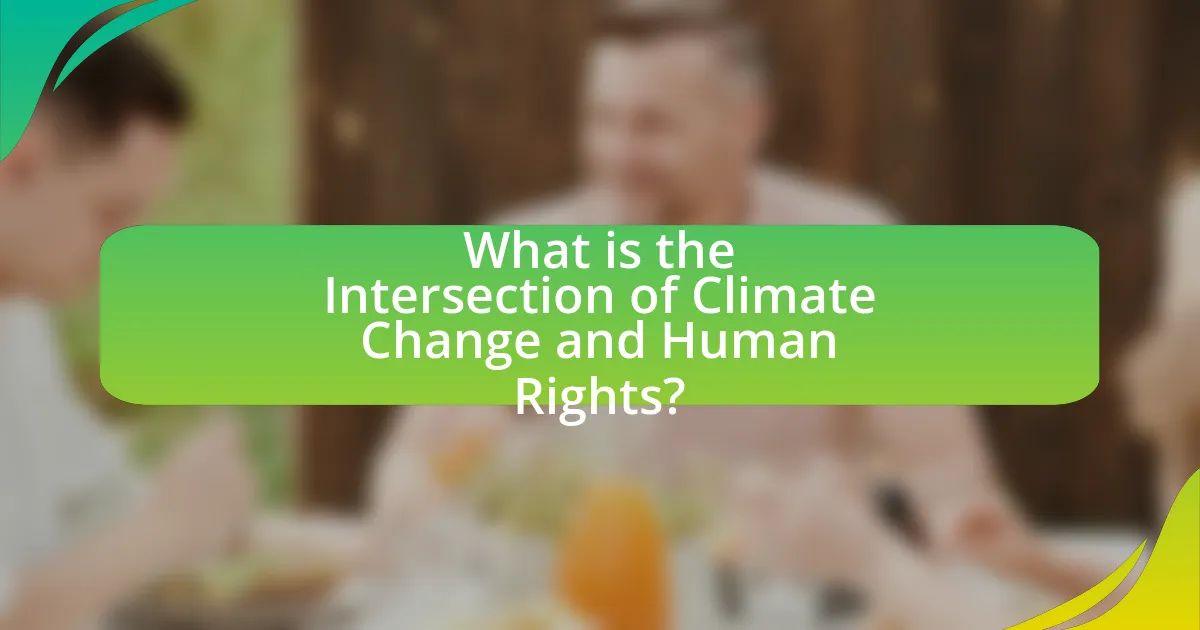
What is the Intersection of Climate Change and Human Rights?
The intersection of climate change and human rights lies in the impact that environmental degradation has on the fundamental rights of individuals and communities. Climate change exacerbates issues such as food security, access to clean water, and health, which are essential for the realization of human rights. For instance, the United Nations recognizes that climate change disproportionately affects vulnerable populations, including indigenous peoples and low-income communities, thereby threatening their rights to life, health, and adequate living standards. Reports from organizations like Human Rights Watch and the Intergovernmental Panel on Climate Change (IPCC) highlight that climate-related disasters can lead to displacement, loss of livelihoods, and increased conflict, further violating human rights.
How do climate change and human rights relate to each other?
Climate change and human rights are interconnected as climate change poses significant threats to the realization of fundamental human rights, including the rights to life, health, food, water, and housing. The United Nations has recognized that climate change impacts disproportionately affect vulnerable populations, leading to increased poverty, displacement, and health risks. For instance, the Intergovernmental Panel on Climate Change (IPCC) reports indicate that rising temperatures and extreme weather events can exacerbate food insecurity and force communities to migrate, thereby infringing on their rights. This relationship highlights the necessity for climate action to be integrated into human rights frameworks to protect individuals and communities from the adverse effects of climate change.
What are the key human rights affected by climate change?
Climate change significantly affects several key human rights, including the right to life, the right to health, the right to food, and the right to water. The right to life is threatened by extreme weather events, such as hurricanes and floods, which can lead to loss of life and displacement. The right to health is compromised as climate change contributes to the spread of diseases and exacerbates health conditions due to air pollution and heatwaves. The right to food is impacted by changing agricultural conditions, leading to food insecurity and malnutrition. Lastly, the right to water is jeopardized as climate change affects water availability and quality, making it difficult for communities to access safe drinking water. These connections are supported by reports from organizations like the United Nations, which highlight the direct correlation between climate change and the erosion of these fundamental human rights.
How does climate change impact vulnerable populations?
Climate change significantly impacts vulnerable populations by exacerbating existing inequalities and increasing their exposure to environmental hazards. These populations, often characterized by low income, limited access to resources, and geographic disadvantage, face heightened risks from extreme weather events, food insecurity, and health issues. For instance, according to the Intergovernmental Panel on Climate Change (IPCC), marginalized communities are more likely to suffer from the effects of climate-related disasters, such as floods and droughts, which can lead to displacement and loss of livelihoods. Additionally, a study published in the journal “Nature Climate Change” highlights that climate change disproportionately affects women and children in developing countries, who often have fewer adaptive capacities and resources to cope with these changes.
Why is it important to address human rights in climate change discussions?
Addressing human rights in climate change discussions is crucial because climate change disproportionately affects vulnerable populations, leading to violations of their rights. For instance, the United Nations has reported that climate change exacerbates poverty, food insecurity, and displacement, which directly impacts the rights to life, health, and adequate living standards. Furthermore, integrating human rights into climate policies ensures that marginalized communities are included in decision-making processes, promoting equity and justice. This approach aligns with international human rights frameworks, such as the Paris Agreement, which recognizes the need to protect the rights of those most affected by climate impacts.
What are the consequences of ignoring human rights in climate policies?
Ignoring human rights in climate policies leads to increased vulnerability and marginalization of affected communities. When climate policies do not consider human rights, marginalized groups, such as indigenous peoples and low-income communities, often face disproportionate impacts from climate change, including loss of land, displacement, and lack of access to resources. For instance, the United Nations has reported that climate change exacerbates existing inequalities, making it essential to integrate human rights into climate action to ensure equitable outcomes. Failure to do so can result in social unrest, increased poverty, and violations of fundamental rights, as seen in various regions where climate-related displacement has occurred without adequate protections.
How can human rights frameworks enhance climate action?
Human rights frameworks can enhance climate action by ensuring that climate policies respect, protect, and fulfill the rights of individuals and communities affected by climate change. These frameworks provide a legal basis for holding governments and corporations accountable for their environmental actions, thereby promoting equitable and just climate solutions. For instance, the United Nations Human Rights Council has recognized that climate change poses a significant threat to the enjoyment of human rights, emphasizing the need for states to integrate human rights considerations into their climate strategies. This integration can lead to more inclusive decision-making processes, ensuring that marginalized groups, who are often the most affected by climate impacts, have a voice in climate action initiatives.
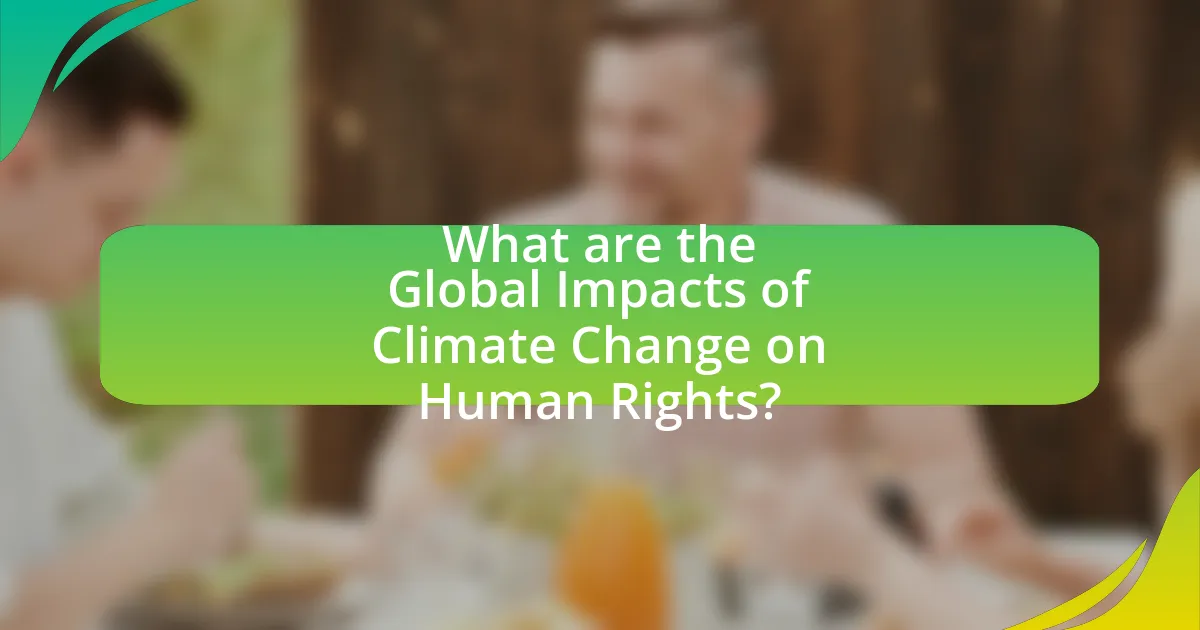
What are the Global Impacts of Climate Change on Human Rights?
Climate change significantly impacts human rights globally by exacerbating issues such as food security, health, and displacement. For instance, rising temperatures and extreme weather events threaten agricultural productivity, leading to food shortages and increased malnutrition, which violate the right to adequate food. Additionally, climate change contributes to the spread of diseases, undermining the right to health, as seen in regions where vector-borne diseases are becoming more prevalent due to changing climates. Furthermore, millions are displaced due to climate-related disasters, infringing on the right to housing and security. According to the United Nations, by 2050, climate change could displace over 200 million people, highlighting the urgent need to address these interconnected human rights issues.
How does climate change affect access to clean water and food?
Climate change significantly reduces access to clean water and food by altering precipitation patterns and increasing the frequency of extreme weather events. These changes lead to droughts, floods, and shifts in agricultural productivity, which directly impact water availability and food security. For instance, the Intergovernmental Panel on Climate Change (IPCC) reports that climate change could decrease crop yields by up to 25% in some regions by 2050, exacerbating food scarcity. Additionally, rising temperatures can lead to increased evaporation rates, further diminishing freshwater supplies. Consequently, vulnerable populations face heightened risks of malnutrition and waterborne diseases, illustrating the critical link between climate change, clean water, and food access.
What regions are most at risk for water scarcity due to climate change?
Regions most at risk for water scarcity due to climate change include the Middle East, North Africa, South Asia, and parts of Sub-Saharan Africa. These areas face significant challenges due to rising temperatures, altered precipitation patterns, and increased evaporation rates. For instance, the Intergovernmental Panel on Climate Change (IPCC) reports that by 2050, water scarcity could affect up to 1.8 billion people, particularly in these regions, where water resources are already limited. Additionally, the World Resources Institute identifies countries like Yemen, Iraq, and Afghanistan as experiencing severe water stress, exacerbated by climate change impacts.
How does food insecurity relate to climate-induced displacement?
Food insecurity is directly linked to climate-induced displacement as extreme weather events and changing climate conditions disrupt agricultural production, leading to food shortages. For instance, the Intergovernmental Panel on Climate Change (IPCC) reports that climate change can reduce crop yields by up to 25% in some regions, exacerbating hunger and forcing populations to migrate in search of stable food sources. This migration often occurs from rural areas to urban centers or across borders, as individuals and families flee areas where their livelihoods are no longer sustainable due to climate impacts.
What role do governments play in protecting human rights amid climate change?
Governments play a crucial role in protecting human rights amid climate change by implementing policies that mitigate its impacts and safeguard vulnerable populations. They are responsible for creating and enforcing laws that address environmental degradation, promote sustainable development, and ensure access to essential resources like clean water and air. For instance, the Paris Agreement, adopted by nearly all countries, emphasizes the need for nations to commit to reducing greenhouse gas emissions, which directly affects the rights to health, food, and shelter. Furthermore, governments can establish frameworks for climate justice, ensuring that marginalized communities receive support and protection from climate-related harms, as highlighted in reports by the United Nations Human Rights Council.
How can national policies integrate human rights into climate strategies?
National policies can integrate human rights into climate strategies by ensuring that climate actions respect, protect, and fulfill human rights obligations. This integration can be achieved through the establishment of legal frameworks that incorporate human rights assessments in climate decision-making processes, ensuring participation of affected communities, and addressing the disproportionate impacts of climate change on vulnerable populations. For instance, the Paris Agreement emphasizes the importance of equity and the rights of indigenous peoples, which highlights the necessity of aligning climate policies with human rights standards. Furthermore, countries like Costa Rica have demonstrated successful integration by embedding human rights considerations into their national climate plans, thereby promoting social justice alongside environmental sustainability.
What international agreements address the intersection of climate change and human rights?
International agreements that address the intersection of climate change and human rights include the Paris Agreement and the United Nations Framework Convention on Climate Change (UNFCCC). The Paris Agreement, adopted in 2015, emphasizes the importance of protecting human rights in the context of climate action, particularly for vulnerable populations. The UNFCCC, established in 1992, recognizes the need to consider the impacts of climate change on human rights, particularly in its preamble and various decisions made during its Conference of the Parties (COP) meetings. These agreements collectively highlight the obligation of states to respect, protect, and fulfill human rights while addressing climate change.
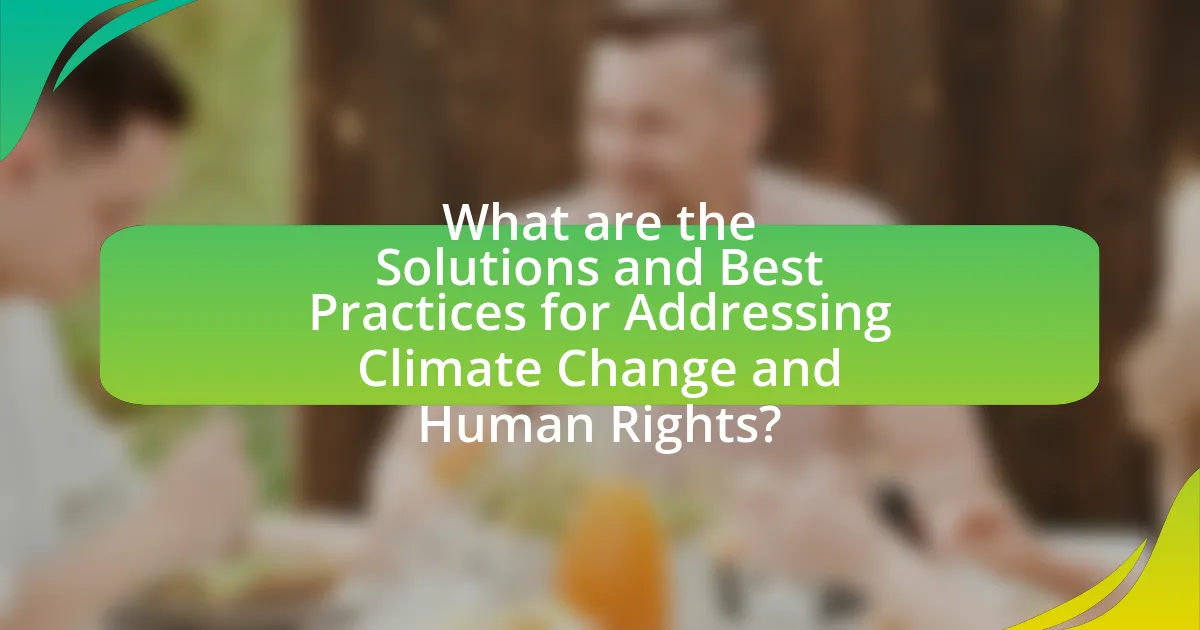
What are the Solutions and Best Practices for Addressing Climate Change and Human Rights?
Solutions and best practices for addressing climate change and human rights include integrating human rights frameworks into climate policies, promoting climate justice, and ensuring participation of marginalized communities in decision-making processes. Integrating human rights frameworks ensures that climate actions respect, protect, and fulfill human rights obligations, as highlighted by the United Nations Human Rights Council’s resolutions on climate change. Promoting climate justice addresses the disproportionate impacts of climate change on vulnerable populations, as evidenced by the 2018 IPCC report, which emphasizes the need for equitable adaptation strategies. Ensuring participation of marginalized communities allows for inclusive governance, which is essential for effective climate action, as demonstrated by successful community-led initiatives in various countries.
How can communities advocate for their rights in the context of climate change?
Communities can advocate for their rights in the context of climate change by organizing collective actions, engaging in policy advocacy, and utilizing legal frameworks. Collective actions, such as protests and awareness campaigns, empower communities to voice their concerns and demand accountability from governments and corporations. Engaging in policy advocacy involves participating in local and national dialogues to influence climate policies that affect their rights, ensuring that their needs and perspectives are included in decision-making processes. Additionally, communities can leverage legal frameworks, such as human rights laws, to challenge actions that violate their rights due to climate change impacts, as seen in cases like the Urgenda Foundation v. State of the Netherlands, where the court ruled that the government must reduce greenhouse gas emissions to protect citizens’ rights.
What strategies can be employed to raise awareness about climate justice?
To raise awareness about climate justice, strategies such as community engagement, educational campaigns, and leveraging social media can be employed. Community engagement involves organizing local events and discussions that highlight the impacts of climate change on marginalized groups, fostering a sense of urgency and collective action. Educational campaigns can utilize workshops and seminars to inform individuals about the connections between climate change and human rights, emphasizing the disproportionate effects on vulnerable populations. Social media platforms serve as powerful tools to disseminate information rapidly, mobilize support, and connect activists globally, as evidenced by movements like Fridays for Future, which has successfully raised awareness among millions about climate justice issues.
How can grassroots movements influence climate policy?
Grassroots movements can influence climate policy by mobilizing public support, raising awareness, and advocating for systemic change. These movements often engage communities directly affected by climate change, amplifying their voices and concerns to policymakers. For instance, the global youth-led climate strikes initiated by movements like Fridays for Future have successfully pressured governments to adopt more ambitious climate targets, as evidenced by increased commitments from various nations following these demonstrations. Additionally, grassroots organizations often collaborate with scientists and experts to provide credible data and research, further strengthening their advocacy efforts. This combination of community engagement, public pressure, and evidence-based advocacy demonstrates the significant impact grassroots movements can have on shaping climate policy.
What are the best practices for integrating human rights into climate action plans?
The best practices for integrating human rights into climate action plans include conducting human rights impact assessments, ensuring stakeholder participation, and aligning climate policies with international human rights standards. Human rights impact assessments identify potential adverse effects of climate actions on vulnerable populations, ensuring that their rights are protected. Stakeholder participation, particularly from marginalized communities, fosters inclusivity and ensures that diverse perspectives inform climate strategies. Aligning climate policies with international human rights standards, such as the Universal Declaration of Human Rights, reinforces the commitment to uphold human dignity while addressing climate change. These practices are essential for creating equitable and effective climate action plans that respect and promote human rights.
How can organizations measure the human rights impacts of climate initiatives?
Organizations can measure the human rights impacts of climate initiatives by employing a combination of quantitative and qualitative assessments. Quantitative methods include analyzing data on displacement, health outcomes, and economic impacts related to climate policies, while qualitative assessments involve stakeholder consultations and human rights impact assessments (HRIAs) to gather personal experiences and perceptions. For instance, the UN Guiding Principles on Business and Human Rights emphasize the importance of due diligence processes that include assessing potential human rights risks associated with climate initiatives. By integrating these approaches, organizations can effectively evaluate how climate initiatives affect vulnerable populations and ensure accountability in their implementation.
What role does education play in promoting climate and human rights awareness?
Education plays a crucial role in promoting climate and human rights awareness by equipping individuals with the knowledge and skills necessary to understand and address these interconnected issues. Through curricula that integrate climate science, social justice, and human rights principles, education fosters critical thinking and empowers students to advocate for sustainable practices and equitable policies. For instance, studies show that educational programs focused on environmental justice can increase awareness of how climate change disproportionately affects marginalized communities, thereby encouraging activism and informed decision-making. This connection between education and advocacy is supported by research from the United Nations Educational, Scientific and Cultural Organization (UNESCO), which emphasizes that education is essential for fostering a culture of sustainability and human rights.
What practical steps can individuals take to support climate justice?
Individuals can support climate justice by reducing their carbon footprint through lifestyle changes such as using public transportation, adopting a plant-based diet, and conserving energy at home. These actions directly decrease greenhouse gas emissions, which disproportionately affect marginalized communities. For instance, a study by the Intergovernmental Panel on Climate Change indicates that transportation and food production are significant contributors to global emissions, highlighting the impact of individual choices on climate change. Additionally, individuals can advocate for policies that promote environmental equity, participate in local climate action groups, and support businesses that prioritize sustainability. Engaging in these practices not only fosters a more equitable society but also aligns with the principles of human rights by ensuring that vulnerable populations are protected from the adverse effects of climate change.
